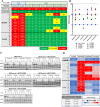Foretinib can overcome common on-target resistance mutations after capmatinib/tepotinib treatment in NSCLCs with MET exon 14 skipping mutation
- PMID: 35690785
- PMCID: PMC9188708
- DOI: 10.1186/s13045-022-01299-z
Foretinib can overcome common on-target resistance mutations after capmatinib/tepotinib treatment in NSCLCs with MET exon 14 skipping mutation
Abstract
Background: Capmatinib and tepotinib are guideline-recommended front-line treatments for non-small-cell lung cancer (NSCLC) patients with MET exon 14 skipping mutations (METex14). However, the emergence of acquired resistance to capmatinib/tepotinib is almost inevitable partially due to D1228X or Y1230X secondary mutations of the MET. In this study, we explored agents that are active against both D1228X and Y1230X MET to propose an ideal sequential treatment after capmatinib/tepotinib treatment failure in NSCLC patients with METex14.
Methods: The inhibitory effects of 300 drugs, including 33 MET-TKIs, were screened in Ba/F3 cells carrying METex14 plus MET D1228A/Y secondary mutations. The screen revealed four-candidate type II MET-TKIs (altiratinib, CEP-40783, foretinib and sitravatinib). Therefore, we performed further growth inhibitory assays using these four MET-TKIs plus cabozantinib and merestinib in Ba/F3 cells carrying MET D1228A/E/G/H/N/V/Y or Y1230C/D/H/N/S secondary mutations. We also performed analyses using Hs746t cell models carrying METex14 (with mutant allele amplification) with/without D1228X or Y1230X in vitro and in vivo to confirm the findings. Furthermore, molecular dynamics (MD) simulations were carried out to examine differences in binding between type II MET-TKIs.
Results: All 6 type II MET-TKIs were active against Y1230X secondary mutations. However, among these 6 agents, only foretinib showed potent activity against D1228X secondary mutations of the MET in the Ba/F3 cell and Hs746t in vitro model and Hs746t in vivo model, and CEP-40783 and altiratinib demonstrated some activity. MD analysis suggested that the long tail of foretinib plays an important role in binding D1228X MET through interaction with a residue at the solvent front (G1163). Tertiary G1163X mutations, together with L1195F/I and F1200I/L, occurred as acquired resistance mechanisms to the second-line treatment foretinib in Ba/F3 cell models.
Conclusions: The type II MET-TKI foretinib may be an appropriate second-line treatment for NSCLCs carrying METex14 after campatinib/tepotinib treatment failure by secondary mutations at residue D1228 or Y1230.
© 2022. The Author(s).
Conflict of interest statement
Dr. Fujino has received research funding from Apollomics and Brighe Biotherapeutic and lecture fees from Novartis. Dr. Suda has received honoraria from Boehringer Ingelheim, Chugai and Taiho, has been on the advisory board of AstraZeneca, and has received research funding from Boehringer Ingelheim and Rain Therapeutics, outside of the submitted work. Dr. Koga has received research funding from Boehringer Ingelheim, outside of the submitted work. Dr. Hamada has received lecture fees from AstraZeneca and Chugai outside of the submitted work. Dr. Chiba has received honorarium from Ethicon, Olympus, B-Braun, and Covidien outside of the submitted work. Dr. Soh has received honoraria from Johnson and Johnson, Intutive, and AstraZeneca, outside the submitted work. Dr. Mitsudomi has received lecture fees from AstraZeneca, Boehringer Ingelheim, Chugai, and Pfizer and research funding from Astra Zeneca, Boehringer Ingelheim, and Chugai; in addition, he has been on the advisory board of Novartis and received lecture fees from Bristol-Myers Squibb, Eli Lilly, Merck Sharp and Dohme. Dr. Mitsudomi has also received research funding from Daiichi Sankyo, Taiho, and Ono Pharmaceutical, outside of the submitted work.
Figures





References
-
- Paik PK, Felip E, Veillon R, Sakai H, Cortot AB, Garassino MC, Mazieres J, Viteri S, Senellart H, Van Meerbeeck J, Raskin J, Reinmuth N, Conte P, Kowalski D, Cho BC, Patel JD, Horn L, Griesinger F, Han J-Y, Kim Y-C, Chang G-C, Tsai C-L, Yang JC-H, Chen Y-M, Smit EF, van der Wekken AJ, Kato T, Juraeva D, Stroh C, Bruns R, Straub J, Johne A, Scheele J, Heymach JV, Le X. Tepotinib in non–small-cell lung cancer with MET exon 14 skipping mutations. N Engl J Med. 2020;383(10):931–943. doi: 10.1056/NEJMoa2004407. - DOI - PMC - PubMed
-
- Baltschukat S, Schacher Engstler B, Huang A, Hao HX, Tam A, Wang HQ, Liang J, DiMare MT, Bhang HC, Wang Y, et al. Capmatinib (INC280) is active against models of non-small cell lung cancer and other cancer types with defined mechanisms of MET activation. Clin Cancer Res. 2019 doi: 10.1158/1078-0432.CCR-18-2814. - DOI - PubMed
-
- Bladt F, Faden B, Friese-Hamim M, Knuehl C, Wilm C, Fittschen C, Gradler U, Meyring M, Dorsch D, Jaehrling F, et al. EMD 1214063 and EMD 1204831 constitute a new class of potent and highly selective c-Met inhibitors. Clin Cancer Res. 2013;19:2941–2951. doi: 10.1158/1078-0432.CCR-12-3247. - DOI - PubMed
Publication types
MeSH terms
Substances
Grants and funding
LinkOut - more resources
Full Text Sources
Medical
Research Materials
Miscellaneous

